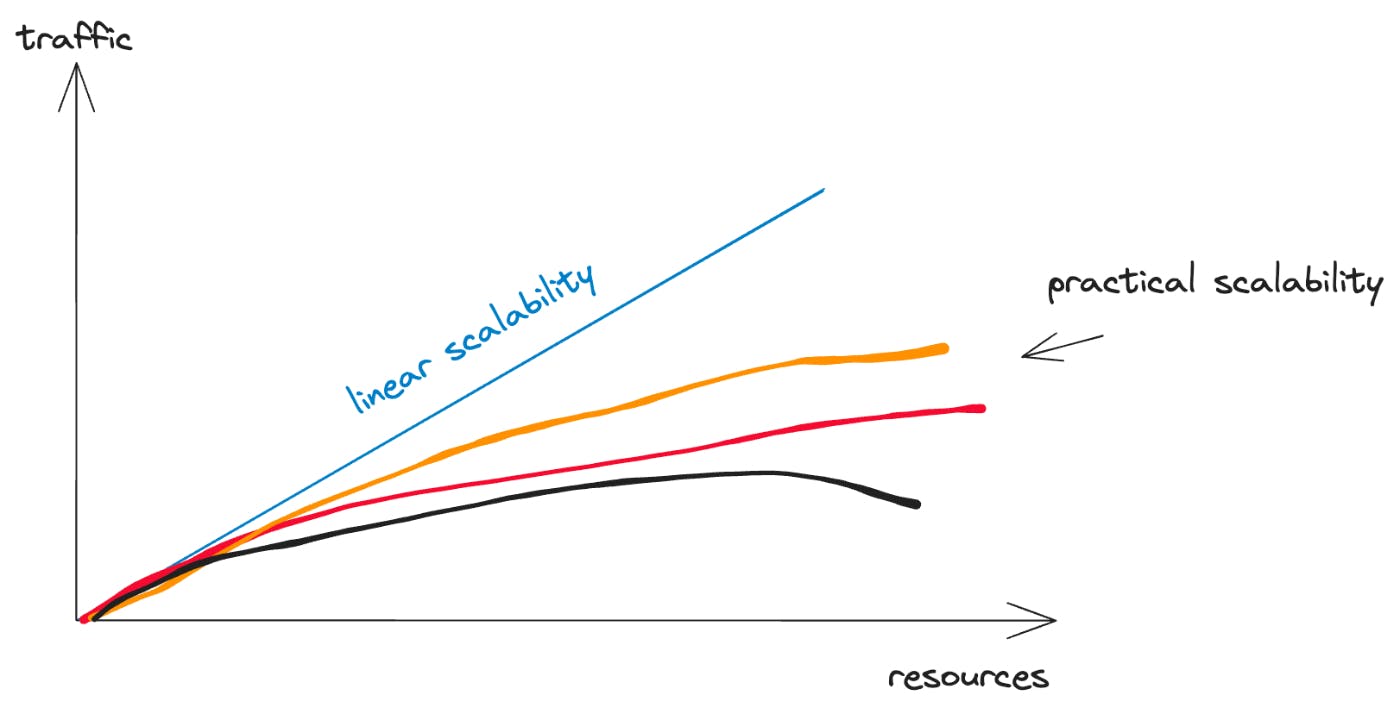When it comes to the world of tech, system architects are continually challenged with designing systems that can handle increasing workloads and traffic while maintaining optimal performance and reliability. Generally, the most optimistic scenario we can have is linear scalability. For example, if we're to double the amount of resources, we could get double the number of well-handled requests. However, in practice, linear scalability is very hard to achieve.
Two fundamental approaches to addressing scalability are horizontal scaling and vertical scaling. In this post, we will delve into the key differences between these two approaches, their advantages, and considerations when deciding which one to implement in your system architecture design.
Horizontal Scaling
Imagine your system as a team of superheroes. When you need more power, you don't just make one hero stronger; you add more heroes to the squad. That's what horizontal scaling is all about. Horizontal scaling, often referred to as "scaling out," involves adding more machines or nodes to your system to distribute the workload. This approach is particularly well-suited for systems that need to handle growing user traffic or increasing data processing demands. By adding more resources in parallel, horizontal scaling can improve system performance and fault tolerance.
Advantages of Horizontal Scaling:
- Improved Scalability: Horizontal scaling allows for almost limitless expansion of your system's capacity. As your user base or workload increases, you can simply add more servers to accommodate the demand.
- Enhanced Fault Tolerance: Distributing workloads across multiple nodes reduces the risk of a single point of failure. If one node fails, the load can be automatically redistributed to other nodes.
- Cost-Effective: Horizontal scaling often makes use of commodity hardware, which can be more cost-effective than purchasing a single, mega-powered machine.
Considerations for Horizontal Scaling:
- Data Consistency: Maintaining data consistency across multiple nodes can be challenging. Database replication and synchronization strategies are necessary to ensure data integrity.
- Complex Load Balancing: Effective load balancing is crucial for ensuring that traffic is evenly distributed across all nodes. Implementing a robust load-balancing strategy is vital.
- Stateless Architecture: Horizontal scaling requires a stateless architecture where each request to the server can be handled independently without relying on the server's local state.
Vertical Scaling
Vertical scaling, also known as "scaling up," involves adding more resources (CPU, memory, storage) to a single machine or node to enhance its performance. This approach is typically used when your system reaches its hardware limits and you need more processing power or memory to handle increased workloads. It's like leveling up a single hero, giving them more muscle, memory, and superpowers. This approach is your go-to when your current hero is hitting the gym's ceiling.
Advantages of Vertical Scaling:
- Simplified Management: Managing a single, powerful machine can be more straightforward than overseeing a cluster of multiple nodes, resulting in potentially lower operational overhead.
- Consistency: Data consistency is often more straightforward to maintain in a vertical scaling model, as all data resides on a single machine.
- Performance Gains: Vertical scaling can provide a significant boost in performance when additional resources are added to a single machine.
Considerations for Vertical Scaling:
- Limited Scalability: Vertical scaling has limitations, as there is a practical limit to how much you can upgrade a single machine. At some point, further upgrades may become prohibitively expensive or technically unfeasible.
- Single Point of Failure: Relying on a single machine means that if it fails, your entire system may become unavailable. Redundancy and failover mechanisms are critical for mitigating this risk.
Choosing the Right Approach
The decision between horizontal and vertical scaling should be based on your specific system requirements, constraints, and goals. Some considerations include:
- Workload Characteristics: Consider the nature of your workload. Horizontal scaling is well-suited for distributed and stateless workloads, while vertical scaling may be preferable for single-threaded or stateful workloads.
- Cost and Budget: Assess your budget and resource availability. Horizontal scaling can be cost-effective, especially when using commodity hardware, while vertical scaling may require a more substantial upfront investment in high-end hardware.
- Performance and Maintenance: Evaluate the performance gains and management complexity associated with each approach. Consider how each choice aligns with your operational capabilities and goals.
- Future Growth: Think about your system's long-term scalability needs. If you anticipate significant growth, horizontal scaling may offer more flexibility.
Conclusion
Horizontal scaling and vertical scaling are two essential strategies in system architecture design, each with its own advantages and considerations. The choice between these approaches depends on your specific requirements, budget, and the nature of your workload. Ultimately, the ideal solution may involve a combination of both horizontal and vertical scaling, striking a balance that meets your system's performance, reliability, and scalability needs.
Also published here.


